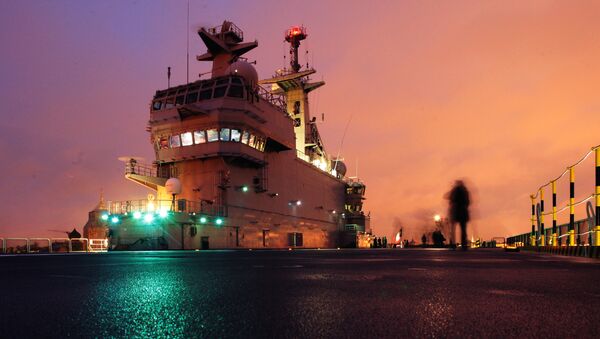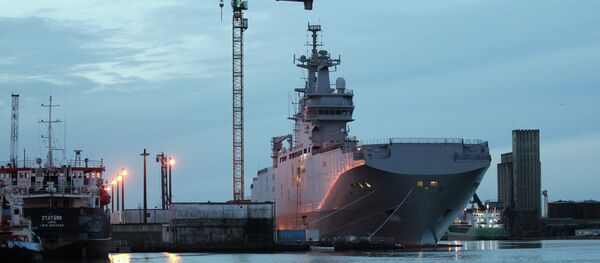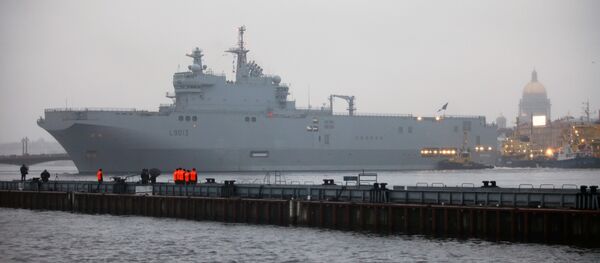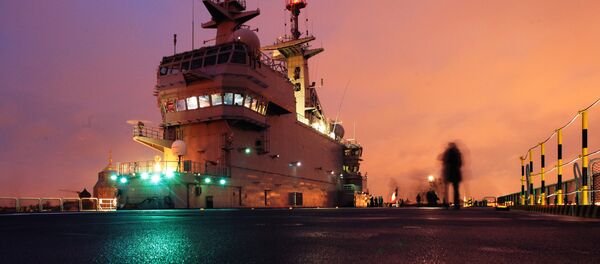MOSCOW, November 25 (Sputnik) — French President Francois Hollande announced on Tuesday that the transfer of the first Mistral-class helicopter carrier to Russia was put on hold over the situation in Ukraine.
France started developing these ships in 1997 in line with the National Concept for Amphibious Operations. The first ship was designed by the General Delegation for Armaments and French naval defense and energy group DCNS. Several foreign contractors were also involved in the program.
Finland's Wartsila Corporation built the diesel generators for the ships, while Rolls Royce's Swedish subsidiary provided the Azipod screw and steering columns. Polish Stocznia Remontowa de Gdansk developed the hull's midsection housing and helicopter hangar. Thales Group, an international industrial conglomerate, contributed the combat data network and ship detection systems. Leading missile and missile systems manufacturer MBDA contributed the ship's surface-to-air missiles.
In October 2004, the French Navy's first amphibious assault ship, the Mistral, was launched at the Brest shipyard in western France.
The ship's hull has no armor plating. The Mistral can reach a maximum speed in excess of 18 knots (about 33 kph) and has a maximum range of up to 20,000 nautical miles (about 37,000 kilometers). The ship has a crew of 160 and can carry more than 450 soldiers. Its air wing includes 16 helicopters, including up to six simultaneously deployed on the flight deck.
Its helicopter hangar, with an effective storage capacity of about 1,800 square meters (19,000 square feet), is located under the flight deck and in the ship's stern section. Two elevators are used to lift the helicopters onto the flight deck and return them to the hangar. Marine units and their armored vehicles can either land on piers at fully-equipped ports or they can sail ashore on landing craft. Each Mistral-class ship has an internal dock with a total area of about 2,650 square meters to hold two 95-ton hovercraft or four smaller landing craft.
Each Mistral-class ship has an 850 square meter command and control center for coordinating various military operations of any scale, including detached missions. These well-equipped command centers can accommodate up to 200 specialists. The ship also has a hospital for 69 patients and extra beds for more, as well as two surgical units and a radiography room.
A unique control system was developed especially for Mistral-class ships. Highly automated systems made it possible to considerably reduce the number of sailors necessary for the ship's operation and to more effectively control it and its air wings. The multifunctional and versatile data network the ships use can be easily integrated into similar networks used by foreign armed forces.
In June 2009, St. Petersburg hosted the Fourth International Naval Salon, with French experts unveiling the design of a Mistral-class ship that Russian analysts responded positively to.
On June 17, 2011, Russian state arms exporter Rosoboronexport and DCNS signed a 1.2 billion euro contract for Russia"s purchase of two Mistral-class ships and related services, which includes logistics, personnel training and technology transfers. Under the contract, Russia was to receive the first two ships in 2014 and 2015.
These ships were expected to be used to transport Russian marine units, ensure the military's long-term presence in remote regions lacking military bases and to provide air support. They would beef up the Admiral Kuznetsov aircraft carrier and its aging air wing, which was rarely put to sea and also be the Russian Navy's control ships.
The Mistral-class ships Russia ordered would operate Russia-made helicopters, including the Kamov Ka-52K, a carrier-borne version of the famous Ka-52 Alligator/Hokum-B attack helicopter.
The two ships are being built by DCNS and the STX France shipyard in Saint-Nazaire. Russia's United Shipbuilding Corporation is also involved in the program.
Russian companies account for about 40 percent of all construction work.
The Baltic Shipyard facilities in St. Petersburg, part of United Shipbuilding Corporation, were used to manufacture the floating hull sections of both ships.
The keel of the first Mistral-class ship, christened the Vladivostok, was laid on February 1, 2012 in Saint-Nazaire. The STX France shipyard started assembling its bow section a year later. The Baltic Shipyard simultaneously built the stern section that was delivered to France in late July 2013.
In late June, 400 Russian sailors, or two ship crews, arrived in Saint-Nazaire and began their familiarization with the ship"s control systems. On September 13, the Vladivostok was put to sea for the first time with about 200 Russian and 200 French sailors on board. The ship successfully accomplished all its mission's objectives and returned to port about 10 days later. On October 3, the ship put to sea with the second Russian crew onboard and subsequently returned to Saint-Nazaire.
The Federal Service for Military-Technical Cooperation expects the first Mistral-class ship to enter service with the Russian Navy this year. After that, it will be delivered to the Northern Shipyard in St. Petersburg for refitting. Russian weapons systems will also be installed by mid-2015.
The keel of the second Mistral-class ship, christened the Sevastopol, was laid in Saint-Nazaire in June 2013.
Under the contract, the ship is to arrive in St. Petersburg in November 2015. The United States opposes the fulfillment of the contract. Bowing to the US pressure, France has repeatedly threatened to suspend the delivery of both ships. Analysts believe that Russia will not face any major problems even if the Mistral contract is terminated, being able to independently build a similar ship, while France would have to pay a heavy penalty.






